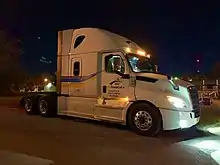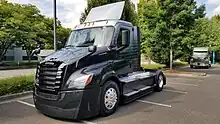| Freightliner Cascadia | |
|---|---|
_Truck_Freightliner_at_Flying_J_Travel_Plaza_(2).jpg.webp) First-generation Freightliner Cascadia (125) | |
| Overview | |
| Manufacturer | Daimler Trucks North America |
| Production | 2007–present |
| Model years | 2008–present |
| Assembly |
|
| Body and chassis | |
| Class | Heavy truck |
| Body style | Conventional |
| Related | Western Star 57x |
| Powertrain | |
| Engine | Detroit DD13/15/16, Cummins ISX15 EPA |
| Transmission | |
| Chronology | |
| Predecessor | Freightliner Century (Columbia) |
Overview
_23.jpg.webp)
The Freightliner Cascadia is a series of heavy-duty semi-trailer trucks produced by Freightliner Trucks. As of the 2024 model year, there have been two generations of Cascadia; Generally, these can be referred to by their internal model designations (Cascadia125 and Cascadia 126, respectively).
Original Design (Cascadia 125)
Its design took fuel efficiency into great consideration, as well as having improved upon several other features including the powertrain offerings, sound mitigation, safety systems, and overall mechanical reliability from its predecessors. It is offered in three basic configurations: Day Cab, Mid-Roof XT, and Raised Roof. The latter two models are sleeper cabs, offered in various lengths, ranging from 48 to 72 inches (Raised Roof models available for 60” or 72” lengths only). The Cascadia was sold chiefly in North America until 2020, when an export, primarily geared towards the Australian and New Zealand markets, was introduced.[1] Prior to the introduction of the export variant, its place remained occupied by the Freightliner Century (no longer in US production) for export markets. Additional variations include the Cascadia 113, which looks nearly identical to the 125, but has a shorter hood and front overhang.
Cascadia Evolution (Cascadia 125 Evo)
The Cascadia Evolution is a more fuel-efficient version of the Cascadia, released in 2013. Improvements were made to both the aerodynamics and the comfort of the driver. The instrument cluster was redesigned to be easier to read, the seats have improved back and lumbar support, dashboard switches are repositioned with larger,[2] higher contrast text, and a battery-powered auxiliary HVAC system from Thermo King was offered. This system was designed to reduce overnight engine idling, both saving fuel and reducing noise while drivers are asleep.
Second Generation (Cascadia 126)

In 2017, the Cascadia received a major design revision for the 2018 model year. The general design of the cab structure looks similar, except for revised chassis fairings and longer cab extenders. The 2018 Cascadia's facelift was extensive and included a new hood cowl with a more sculpted and aggressive design, synchronized by the redesigned front bumper and larger grille with an addition of all-LED headlights. The driver and passenger doors were changed as well, along with their handles inside and out. The hood mirrors were more aerodynamic, following the fuel efficiency design flow and improved bumper air dams and improved (optional) side skirts were installed.[3]
Interior wise, the truck received a complete overhaul. An all-new dashboard along with new, even more, ergonomic seats make the truck very driver-centric and provide superior visibility and comfort. The new Cascadia's sleeper contains a larger bunk than its predecessor as well. Fully redesigned storage cabinets and aircraft-inspired dimmable LED ceiling lights are standard in raised roof sleepers; and the optionally available "Driver's Loft" feature, showcases a retractable central work-table/ dining-area with two foldable seats - all of which stow underneath an extra-wide Murphy-style bunk. If equipped with the upper bunk, the raised roof sleeper also includes a standard telescopic ladder for easier access to the top bunk.[4]
Battery-powered HVAC systems remain an option, however, in addition to the Thermo King units seen on the Cascadia Evolution, Freightliner now offers an internally manufactured equivalent system as well.
Other features of the truck include the Detroit DT12 automated manual transmission, ultra-quiet door and window seals, a single panel windshield, all LED marker lights and taillights, and a suite of active and passive safety systems, including blind-spot monitoring, collision mitigation system and lane-keeping assistance, and more.
The second-generation Cascadia is produced in the same three configurations as its predecessors, Day Cab, Mid-roof XT, and Raised Roof. As with the previous generation Cascadia, Freightliner offered a short-nosed version of the new Cascadia and named the new short-nosed version as the 116 Model.
Due to the slightly different mission/usage requirements for the 116 model, the 116s are typically powered by the Detroit Diesel DD13 series engines (whereas the 126 typically uses the DD15.)

eCascadia
The eCascadia is an all-electric truck variant of the Cascadia. As of 2022, the specifications of the long-range variant include a range of 230 mi (370 km) (single-drive) or 220 mi (350 km) (tandem-drive), using 438-kWh batteries, and 320–470 hp (240–350 kW), with charging to 80% in 90 minutes.[5] It has a GCWR of up to 82,000 lb (37,000 kg), and will compete with the Tesla Semi.[6]
In August 2019, the first two eCascadias were delivered to customers in California as part of field tests. The manufacturer stated that the trucks are built "to test the integration of battery-electric trucks [into] large-scale fleet operations".[7] One of the customers, Penske, will be operating the truck "in regional traffic in Southern California" while the other, NFI, will use it in drayage operations at the Port of Los Angeles and the Port of Long Beach.[8][9]
Order books opened in 2021,[10] and one order was for 800 trucks.[11]

After testing a prototype to more than 1 million miles (1.6 million kilometers), production and official premiere took place in May 2022.[12]
See also
References
- ↑ "Freightliner Truck Models, Truck Features". www.freightliner.com.au. Retrieved April 24, 2021.
- ↑ "2013 Freightliner Cascadia for Sale *2022 Learn More!". Best of Trucks. May 15, 2022. Retrieved June 16, 2022.
- ↑ "Latest Freightliner Cascadia gets SuperTruck-Like Improvements". hankstruckforum.com. Retrieved February 2, 2018.
- ↑ "2017 Freightliner Cascadia For Sale *2022 Learn More!". Best of Trucks. May 28, 2022. Retrieved June 16, 2022.
- ↑ "World premiere of the new battery electric Freightliner eCascadia | Daimler".
- ↑ James Menzies (June 6, 2018). "Freightliner debuts electric Cascadia, M2". Truck News.
- ↑ "First Freightliner eCascadia Battery Electric Trucks Headed to Customers | Daimler".
- ↑ "Daimler delivers its first electric Freightliner eCascadia to US customers - Daimler Global Media Site". Archived from the original on November 1, 2020. Retrieved September 6, 2019.
- ↑ "Daimler delivers its first electric Freightliner eCascadia to US customers".
- ↑ "Daimler Opens Orders for Freightliner eCascadia, eM2".
- ↑ "Electric trucks: Sysco signs for record 800 Freightliner eCascadias | Freight News". Freightalent International.
- ↑ Adler, Alan (May 10, 2022). "Million-mile tested Freightliner eCascadia goes into production". FreightWaves.
- http://www.daimler-trucksnorthamerica.com/news/press-release-detail.aspx#detroit-dt12-automated-manual-transmission-now-2013-09-18, Giroux, David, "Detroit DT12 Automated Manual Transmission Now Available for Detroit DD13 Engine", 09/18/2013
External links
- Freightliner, 2017 Cascadia
- Freightliner, Cascadia Evolution
- Detroit DT12